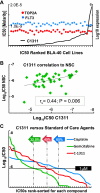Use of yeast chemigenomics and COXEN informatics in preclinical evaluation of anticancer agents
- PMID: 21253455
- PMCID: PMC3023847
- DOI: 10.1593/neo.101214
Use of yeast chemigenomics and COXEN informatics in preclinical evaluation of anticancer agents
Abstract
Bladder cancer metastasis is virtually incurable with current platinum-based chemotherapy. We used the novel COXEN informatic approach for in silico drug discovery and identified NSC-637993 and NSC-645809 (C1311), both imidazoacridinones, as agents with high-predicted activity in human bladder cancer. Because even highly effective monotherapy is unlikely to cure most patients with metastasis and NSC-645809 is undergoing clinical trials in other tumor types, we sought to develop the basis for use of C1311 in rational combination with other agents in bladder cancer. Here, we demonstrate in 40 human bladder cancer cells that the in vitro cytotoxicity profile for C1311 correlates with that of NSC-637993 and compares favorably to that of standard of care chemotherapeutics. Using genome-wide patterns of synthetic lethality of C1311 with open reading frame knockouts in budding yeast, we determined that combining C1311 with a taxane could provide mechanistically rational combinations. To determine the preclinical relevance of these yeast findings, we evaluated C1311 singly and in doublet combination with paclitaxel in human bladder cancer in the in vivo hollow fiber assay and observed efficacy. By applying COXEN to gene expression data from 40 bladder cancer cell lines and 30 human tumors with associated clinical response data to platinum-based chemotherapy, we provide evidence that signatures of C1311 sensitivity exist within nonresponders to this regimen. Coupling COXEN and yeast chemigenomics provides rational combinations with C1311 and tumor genomic signatures that can be used to select bladder cancer patients for clinical trials with this agent.
Figures



References
-
- Botteman MF, Pashos CL, Redaelli A, Laskin B, Hauser R. The health economics of bladder cancer: a comprehensive review of the published literature. Pharmacoeconomics. 2003;21:1315–1330. - PubMed
-
- Stein JP, Lieskovsky G, Cote R, Groshen S, Feng A-C, Boyd S, Skinner E, Bochner B, Thangathurai D, Mikhail M, et al. Radical cystectomy in the treatment of invasive bladder cancer: long-term results in 1,054 patients. J Clin Oncol. 2001;19:666–675. - PubMed
-
- Gallagher DJ, Milowsky MI, Bajorin DF. Advanced bladder cancer: status of first-line chemotherapy and the search for active agents in the second-line setting. Cancer. 2008;113:1284–1293. - PubMed
Publication types
MeSH terms
Substances
Grants and funding
LinkOut - more resources
Full Text Sources
Molecular Biology Databases
